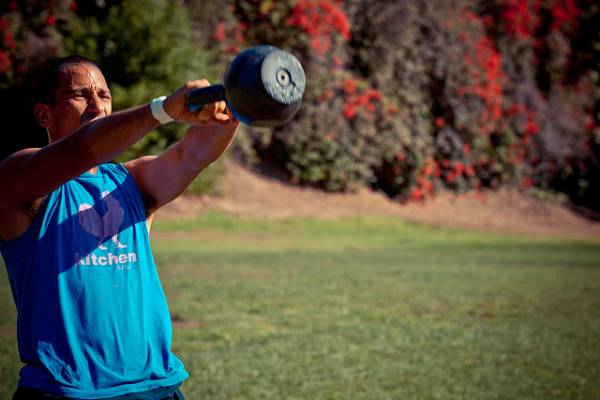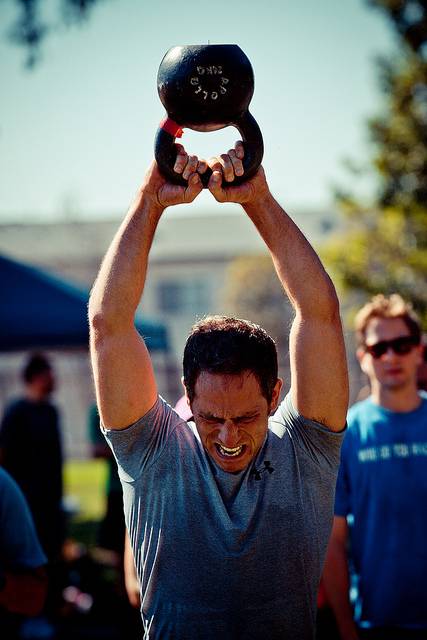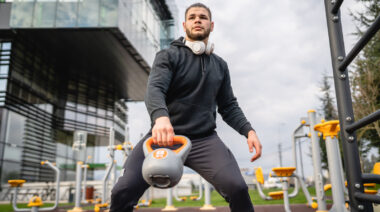The kettlebell swing is a display of skill and strength. If you perform it for an extended period of time, it is also a display of your endurance relative to the resistance used. If your swinging technique is dead-on, you can efficiently move the resistance. If you’re strong, you can swing a heavier kettlebell. If you’re both technically sound and strong, you can swing relatively heavier resistances more efficiently and for an extended period.
The kettlebell swing is a display of skill and strength. If you perform it for an extended period of time, it is also a display of your endurance relative to the resistance used. If your swinging technique is dead-on, you can efficiently move the resistance. If you’re strong, you can swing a heavier kettlebell. If you’re both technically sound and strong, you can swing relatively heavier resistances more efficiently and for an extended period.
Breaking it down, improving your kettlebell swing centers on these factors:
- Skill
- Strength
- Endurance
Swinging Skill
Here is a suggestion to improve technical form – practice swinging the kettlebell! Yep, nothing beats exact practice. I know basic motor learning research has been shunned over the years (why, I don’t know), however proven research shows that exact practice improves desired skill improvement. So, to better your swinging skills, spend time on proper technique swing practice. Activate the applicable muscles in the proper sequence as per the principle of specificity.
The basics of proper form are essentially the same whether you’re performing the CrossFit/American (to overhead) or the RKC (to shoulder height) version, or using one or two arms. The key technical points to practice, practice, and practice are:
- Full-range flexion and extension, or hip hinging. Don’t squat, but be active with optimal hip flexion (backward) followed by explosive hip extension (forward).
- Maintain a neutral spine. No forward shoulder rounding or excess lumbar extension. Make a straight line from the lumbar to the cervical spine.
- Arm or arms completely extended. Do not flex the elbows, similar to the mistake many make during a barbell clean pull from the floor or hang position. Flexing the elbow joints leads to a lack of transfer of momentum. To optimize triple extension (ankle, knee, and hip), keep the arms fully extended.
- Drive the hips and contract glutes. From the hips-flexed position, drive forward to extend the hips by contracting the glutes explosively. As the hips near complete extension, knee extension (quadriceps) and ankle plantar flexion (calves) continue the now upward directed force. Hip unhinging is the impetus for imparting momentum to the resistance forward and upward initially, then knee and ankle extension complete it. Relative to the resistance used, upon complete triple extension the highest speed is attained.
Swinging Strength
Performing the swing in itself is one thing, but fortifying the “participants” of the swing is another. Think of building a house – start with a strong foundation, then a strong outside structure, then strong inside components, and eventually a strong roof. Increase the strength of your calves, quadriceps, hamstrings, low back, and frontal shoulder joint muscles. This will improve your ability to swing heavier kettlebells. Whatever muscle structures you activate during the swing, find a way to apply direct overload to each of them. You’ll be improving the component muscles involved with the skill of swinging.

Maximize each contributing muscle with these options:
- Calves – toe press and heel raise
- Quadriceps – squat, leg press, and deadlift
- Hamstrings and low back – Romanian deadlift, glute/hamstring raise, stiff-leg deadlift, good morning, back extension, and various position leg curls
- Anterior shoulder joint – dumbbell, barbell, or machine front raise and dumbbell, barbell, or machine upright row.
Please don’t regress to the dark ages by confusing strength training with skill training. They are two separate entities.
Swing Endurance
The ability to swing over an extended period of time is a function of efficient swinging technique, being stronger, and the practice of swinging for extended periods of time. Whether it’s ten swings or forty swings, they’re all strength and skill dependent. Confused?
Compare a gorilla-strength person versus a lemur-strength person:
If the gorilla-strength person swung a 16kg kettlebell for maximum repetitions (a relatively light resistance for them), he or she could swing it for many repetitions. The reason is greater strength allows him or her to perform each swing with fewer muscle fibers, thus maintaining a reserve for further swings in sequence.
If the lemur-strength person swung a 16kg kettlebell for maximum repetitions (a relatively heavy resistance for them), the repetition count would be less because the lack of strength would require him or her to activate more muscle fibers initially to complete the task, thus causing fatigue sooner and leaving less of a reserve for further.
Increasing absolute muscular endurance, therefore, is largely dependent upon increasing muscular strength. Better skill improves endurance as well. If you are efficient in your technique, you will only recruit the relative minimal amount of muscle on each swing, leaving more in reserve. Also, sloppy form activates muscles not normally required in the swing (i.e., wasting energy compensating for poor balance or poor timing). Naturally, using more muscle than required leads to an earlier onset of fatigue.

Regarding swing sessions that specifically address swing endurance, there are many options that work. Similar to interval-type training used for other activities and sports, here are three examples of each approach:
Swing for Repetitions
- Six sets of 15 to 20 repetitions
- Eight sets of 12 to 16 repetitions
- 10 sets of 8 to 12 repetitions
Swing for Time
- :35 swing time/:20 rest x six to eight sets
- :25 swing time/:25 rest x eight to 10 sets
- :20 swing time/:15 rest x 12 to 14 sets
Swing for Repetitions and Time
- Six swings every :30 for 10 to 12 rounds
- 10 swings every :45 for 8 to 10 rounds
- 14 swings every 1:00 for 6 to 8 rounds
To logically improve your kettle bellswing ability, keep it simple. Improve your swing skill through proper practice. Improve the strength of your calves, quadriceps, hamstrings, low back, and anterior shoulder muscles to improve your force-generating capacity. Be efficient with your technique to be proficient, conserve energy, and improve your swinging endurance by using various scenarios.
Photos provided by Miguel Tapia Images and CrossFit LA.






